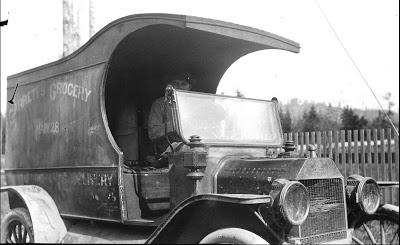
‘We all know eating locally grown foods is best and during the normal harvest season we buy locally when we have the choice.’
By Gerry Storm / The Rag Blog / October 1, 2008
Most models of present and future food distribution assume that the supermarket will be with us until the end of time. It will be this institution that will dictate what we eat and how much it will cost. There are different supermarkets for each neighborhood but they all have much in common, especially shelves filled with junk food which is loaded with preservatives, etc. Companies like General Mills and Kraft and Tyson are represented in most all of these markets.
Most of the fruits and vegetables in these stores are grown in California and shipped all across the USA. In some cases this is good since the fruits are often organically grown and shipped with consummate care in refrigerated trucks. But it is unlikely that you will buy fresh foods at your store unless you live in California. Also, these shipped foods have a shorter shelf life and in spite of being sprayed and treated to make them appear to be fresh, they will spoil quickly after you bring them home. And, of course, the cost in diesel fuel involved in the delivery system is huge, not to mention the smoke it adds to the environment.
We all know eating locally grown foods is best and during the normal harvest season we buy locally when we have the choice. For the rest of the year we buy at the supermarket. While this represents an improvement over the traditional past, it is only a partial answer to the problem. Growing food is not so difficult. Processing it is more difficult. Storing it is the most difficult problem.
While we regularly can foods, dry them, grind them into flours, etc. to have them available in the months between harvests, most all these methods destroy much of the nutrition in the foods. Canning involves lots of heat (fuel intensive) as well as the cost of cans, preservatives and other additives, and labor. It works and we have been relying upon it for some time but those with an eye for the fresh and untampered have learned to look upon it as a last choice. That stuff in the can is not the top of the food chain.
Grinding grains into flour and baking them is also a popular way to consume food. Just one little problem with the idea, by the time the flour is ground and cooked most of the nutrition is destroyed. The processing is also quite fuel intensive from the beginning (grinding mills) to the end (baked in ovens which use gas or electricity). Not all cultures are flour users, some use whole grains that are processed at meal time. It is easier to store whole grains than flour and they will retain their nutritive content longer. But the real potential in economical, simple and effective processing and storing is drying foods, dehydration.
When dried and reconstituted all we have to do is add water and the foods come back to life. Yes, there is some loss in the process but it is really negligible. The conflict here is with our habits, our addiction to the easy life provided by the supermarkets. The Native Americans did not have this luxury and they were quite accustomed to living from harvest to harvest off what they hunted and caught and from what they stored. Dried foods were the norm.
I don’t know that we will be easily converted to this lifestyle but I highly recommend that each of us starts thinking in terms of a food stash consisting of bulk grains and nuts and dried fruits and veggies. Yeah, you can dry meat too if that is on your menu. You don’t have to grind and bake the grains, simply soak them overnight and they will not only be ready to eat but also retain virtually all their nutrition. No heat equals live enzymes.
Another important consideration is the support of small local corporate farms, those owned by stockholders who get their food nearby and thus fresher. You pay the farmer in advance and he does the growing for you. This method insures that the farmer will have the capital to plant without borrowing and also be able to have a bad year due to the natural causes without having to abandon the farm. Small farms are better for a variety of reasons; for one, a big storm is not likely to destroy them all the way it can a large farm (look at the Midwestern floods of 2008); for another, they can specialize more easily and make the delivery process much less costly.
In the future we will have to protect crops more than we do today. This will require extensive use of greenhouses and crop covers. Smaller farms can be more versatile with this. For instance, in years when the grasshopper population is great, the farmer has to cover the crops or lose them, much easier to do on 20 acres than on 2,000. A home garden with a greenhouse nearby, power from small solar and wind generators for every household, battery driven appliances and transportation are the directions our society needs to be moving.
We need to spend quality time rethinking our food production and delivery systems. We need to break the habit of blindly supporting supermarkets and eating whatever they offer. And we need to start eating more dried foods in winter. If you think the stock market crash is terrible for our financial future, think about what happens if the big trucks stop running, even for a few weeks, or global warming takes out one of the big valleys in California. Better to make adjustments now than at the last minute.

















